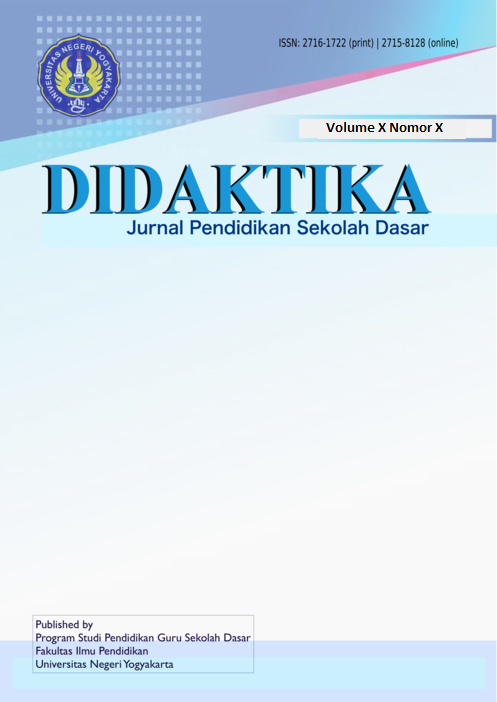Peningkatan Keterampilan Proses IPA Menggunakan Metode Eksperimen pada Siswa Kelas VC SD Bantul Timur
DOI:
https://doi.org/10.21831/didaktika.v1i1.28080Abstract
This study aims to improve the science learning process skills using experimental method in grade fifth C of Bantul Timur Elementary School. This type of research is classroom action research grade fifth C of Bantul Timur elementary school. The design of this study is classroom action research according to Kemmis and McTaggart which consists of action planning, action and observation, and reflection. The data were collected using observation. The data were analyzed using quantitative and qualitative descriptive. The results showed by used experimental method in science learning in the first cycle from 68.13% increased to 80.75% in the second cycle. Students who reach minimum value in the first cycle are 13 students or 43% to 27 students or 90% in cycle II.
References
Dimyati & Moedjiono. (2002). Belajar dan Pembelajaran. Jakarta: Rineka Cipta.
Mulyatiningsih, E. (2013). Metode Penelitian Terapan Bidang Pendidikan. Bandung: Alfabeta.
Ningsih. (2015). Penerapan Metode Eksperimen untuk Meningkatkan Keterampilan Proses pada Pembelajaran IPA Siswa Kelas VI SDN Puro Pakualaman. Thesis. UNY.
Roestiyah. (2008). Strategi Belajar Mengajar, Jakarta : PT Rineka Cipta.
Sagala. (2003). Konsep dan Makna Pembelajaran untuk Membantu Memecahkan Problematika Belajar dan Mengajar. Bandung: Alfabeta
Semiawan, dkk. (2008). Belajar dan Pembelajaran Prasekolah dan Sekolah Dasar. Jakarta: Indeks.
Trianto. (2010). Model Pembelajaran Terpadu Konsep, Strategi, dan Implementasinya dalam KTSP. Jakarta: Bumi Aksara.
Trowbridge, L. W. & Bybee , R. W. (1990). Becoming A Secondary School Science Theacher (fifth edition). Colombus: Merrill Publishing Company.
Wisudawati, A. W., dan Sulistyowati, S. (2013). Metodologi Pembelajaran IPA. Jakarta: Bumi Aksara
Downloads
Published
How to Cite
Issue
Section
Citation Check
License
- Authors retain copyright and grant the journal right of first publication with the work simultaneously licensed under a Creative Commons Attribution License that allows others to share the work with an acknowledgement of the work's authorship and initial publication in this journal.
- Authors are able to enter into separate, additional contractual arrangements for the non-exclusive distribution of the journal's published version of the work (e.g., post it to an institutional repository or publish it in a book), with an acknowledgement of its initial publication in this journal.
- Authors are permitted and encouraged to post their work online (e.g., in institutional repositories or on their website) prior to and during the submission process, as it can lead to productive exchanges, as well as earlier and greater citation of published work.






